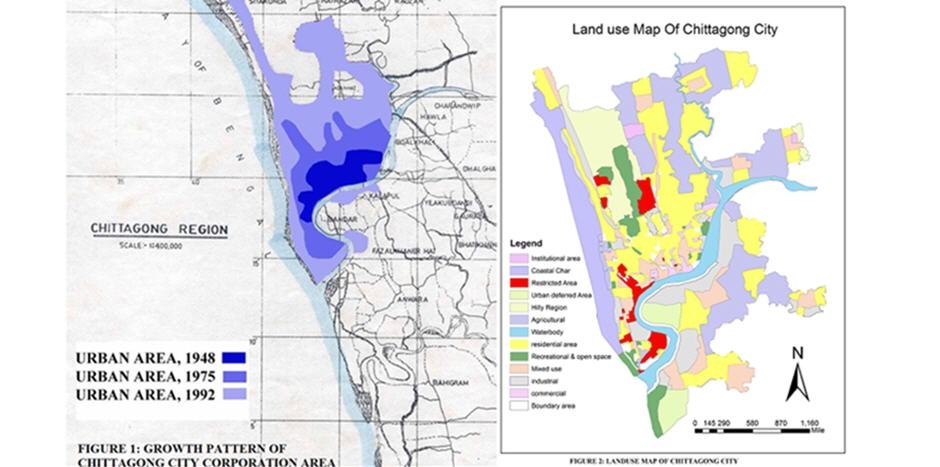The urbanization trend in Chittagong city
Chittagong , Bangladesh
Chittagong is unclassified, irregular and heterogeneous in character of its land use. It is very difficult to identify the zoning in a particular area. Unplanned urbanization creates chaotic development in this city.
People outside the city migrate here for searching job and it creates pressure in the city to survive. For this reason now Chittagong city is suffering various natural and manmade problems.
Unplanned urbanization, disaster and survive from it has a close link. The urbanization trend in Chittagong city corporation area from 1948-1992 is represented by a map in figure 1. And the land use pattern of Chittagong is represented by another map in figure 2.
Every year land slide causes many loss of life because many people live under the hill. No one obey the rules of hill cutting. It is now a burning issue for Chittagong.
According to the Department of Environment, Chittagong, and the district administration have identified 30 hilly areas in Chittagong as risky. 2000 families are at high risk, 4000 to 6000 families are at medium to low risk.
In Foy’s lake area 5000 families are at risk. Now the city is very much affected in water logging problem in rainy season. It is also a result of unplanned urbanization. The inhabitants of the city do not obey the zoning regulations, they construct there buildings and block the natural drainage system.
For constructing new buildings they need more land as the population of the city is increasing at an alarming rate for these reason they destroy pond and other water reservoirs.
Both Chaktai and Rajakhali Khals, two main drainage channels of Chittagong, terminate in the river Karnaphuli. Part of the area is densely populated. Remaining part of the area is expected to be developed in the immediate future as the area falls within Bakalia, earmarked as a thrust area for development in the Structure Plan for Chittagong, 1995.
But now these two khals are in deteriorated condition. No matter, whether the road width is 20 feet or 60 feet, the drain width mysteriously remained constant at 2 to 3 feet. We were very generous in building roads and highways but remained equally miser in building primary, secondary or tertiary drains of appropriate size. As a consequence, as expected, drainage became a menace for our cities.
Last year, 1/3rd of the City of Chittagong went under water during the rainy season (Asraf, Sariful, 2009). In Chittagong hills are an important element in carrying our heritage, culture and physical landscape. For any types of development work we should think about our hills and incorporate it with future management decisions. We should practice sustainable development for keeping our city aesthetically beautiful.
It is our responsibility to maintain our natural landscape. To understand the drainage problem faced by our cities today and to arrive at some planning decisions towards formulating an efficient drainage plan.
If we do not take necessary initiatives for solving these problems we will fall a serious situation in the near future and it will difficult for us to come back. Planned development is a crying need in Chittagong city.
We always say that “old is gold”. For planning Chittagong we should gather knowledge from old Chittagong. We can integrate our nature with our daily activities. We can plan Chittagong in different way. There is no city in the world which has all Things Lake, khals, rivers, sea, hills and port. In early years Chittagong had tradition in trade through its water ways Chaktai to Karnaphully River. We can decorate our city like this way. People can use the traditional boat called “Shampan” in their daily activities. It also reduces pressure on road transport.
For better city we should protect our “Khals and Hills”. Khals remove drainage problem and water logging as well as hills and forest balance heat temperature and look after our environment. Hills connecting road and water bodies create our city as a green city and it looks aesthetically beautiful.
We can go back to our past “journey by boat” in Chittagong city with enjoying attractive hill landscape. Natural resource is always blessing, we don’t want to make it like a curse. We don’t want to make our resource as a “component of disaster”. “We don’t want to cry for spoiled Chtga (Local name of Chittagong).” We can memorize our lovely Chittagong with its river and hills by this local song.
“CHOTO CHOTO DHEO TULI (TULE), LUSAI PAHAR OR TUN (THKE) NAMIERE (NEME), JARGOI (CHOLE JACCHE) KARNAPHULLY.’’
